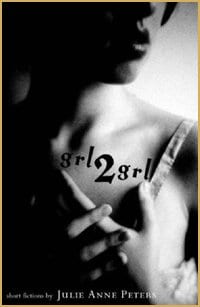On her information-packed website, Colorado-based author Julie Anne Peters explains that her devotion to writing for children and teens is not so much a job as a calling — and one that doesn’t always pay the bills.
“People who write for young readers do it out of love. Period. We’re hungry a lot of the time.”
Love — that great motivator — might inspire Peters to write but what makes her work for teens (such as her novels Luna and Define ‘Normal’) so admirable is her affinity for thoroughly exploring the unlovely, uneasy margins of teenaged society.
Not only does Peters give voice to lesbian, transgender and outsider girl characters, but she offers affirmation of their experiences and perspectives without becoming preachy or dreamily optimistic. Sober realism, her fiction admits to the complexity and cruelty of the world and yet provides maps and directions for navigating through it.
With the slim volume grl2grl (Little, Brown $14), Peters has assembled 10 stories that glimpse into key areas of concern for her readers, from sex education class advice, online socializing and impossible parents to love, heartbreak and the stages in between those two polarities.
The stories (some sweet, lighthearted and funny, others significantly less so) address the fundamental questions of adolescence — “Who am I?” and “Where do I fit in?” — and skillfully illustrate the complex and various ways each might be answered.
Peters also ably dramatizes the other key question for queer youths — coming out and/or staying closeted — with scenarios that are both fresh and relevant.
Though Peters just turned 56, her uncomplicated, matter-of-fact writing style and adoption of current teen lingo enliven her youth-filled stories. And in rendering her characters’ speech and level of sophistication with evident accuracy (the woman obviously spends untold hours in contact with queer teenagers), she assures readers that her stories hold a mirror to their own experiences.
By not presenting a simplistic TV-movie-of-the-week lesson and resolution, Peters treats her readers with a good teacher’s respect — portraying for them viable options and then handing to them the adult responsibility to choose what might work best for them.

 Why you can trust Xtra
Why you can trust Xtra


